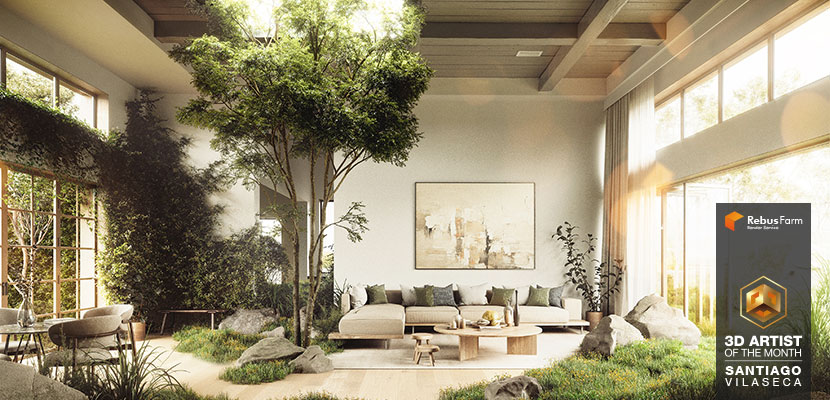
It is once again time to “release the kraken”, as we revisit the wonderful world of Santiago Vilaseca. Spurred on by the emergence of AI generated images, his recent work continues to explore the relationship between architecture and nature. Embracing a more fantastical approach than before, the projects Santiago submitted to our render farm further dissolve the boundaries ‘Between Worlds’.
In our interview, Santiago talks about the importance of social media, introduces his wife’s new interview series, and muses on the impact of recent technological advancement and how it broadened his creative vision.
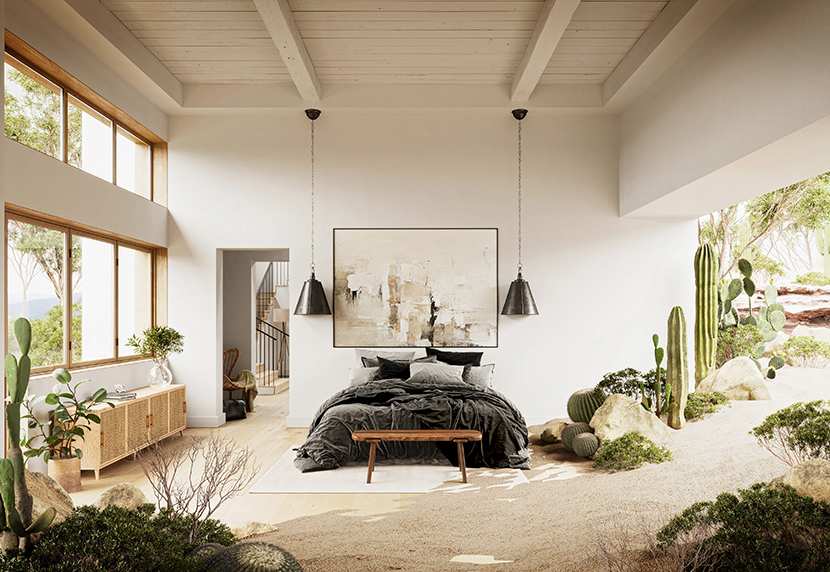 A bedroom in the desert or a desert in the bedroom? Santiago’s work blurs the line not only ‘Between Worlds’ but between the inside and the outside as well.
A bedroom in the desert or a desert in the bedroom? Santiago’s work blurs the line not only ‘Between Worlds’ but between the inside and the outside as well.
Hi Santiago, thanks for joining us again! For those who might have missed our previous interview, please introduce yourself once more!
Hi everyone, thank you for having me again! My name is Santiago and I am a 38-year-old self-taught digital artist based in France, though I am originally from Argentina. My art is inspired by my appreciation for architecture, nature, and biophilic design; I like to explore our connection with nature and how we have removed ourselves further and further in our urban environments. In 2014, I founded KRAKEN Studio with my wife Sélène, a French architect, with the goal of sharing our vision and opening ourselves up to the world as artists.
Almost three years have passed since we last spoke. What have you been up to since then?
Three years, indeed! A lot has happened, especially with the pandemic. It was quite challenging to keep our business going while also taking care of our children during the lockdowns. Fortunately, we managed to find the resources to move forward, and the entire experience only made us stronger. The pandemic also gave us the opportunity to reflect on our work, our goals, and our future. I took a step back to evaluate my work and make sure I was heading in the right direction. All in all, it has been an equally challenging and rewarding process!
Please give us a brief refresher on KRAKEN Studio and your work there.
KRAKEN is a specialized studio focused on creating architectural visualizations. We work with clients from all over the world, but we have a particularly strong ties to France, the country we live in, and to the United States, especially California, where Sélène studied. As for my role at the studio, I am involved in all phases of the image creation process: I oversee the artistic direction of the projects and ensure that we maintain the quality and identity of KRAKEN. Sélène, on the other hand, handles client relations, prospecting, advertising, media, and everything else that is not related to production. We constantly work in pairs, even though each of us has our own field of expertise.
What were some of your personal highlights or favorite projects from recent memory?
I do not really have a favorite project per se – in fact, I would say that all my recent projects are my favorites! Every image I create, or rather, publish, is a reflection of my mood and state of mind at that moment. So, every time I publish an image, it becomes my new favorite because I feel like it represents me and my creative vision at that time.
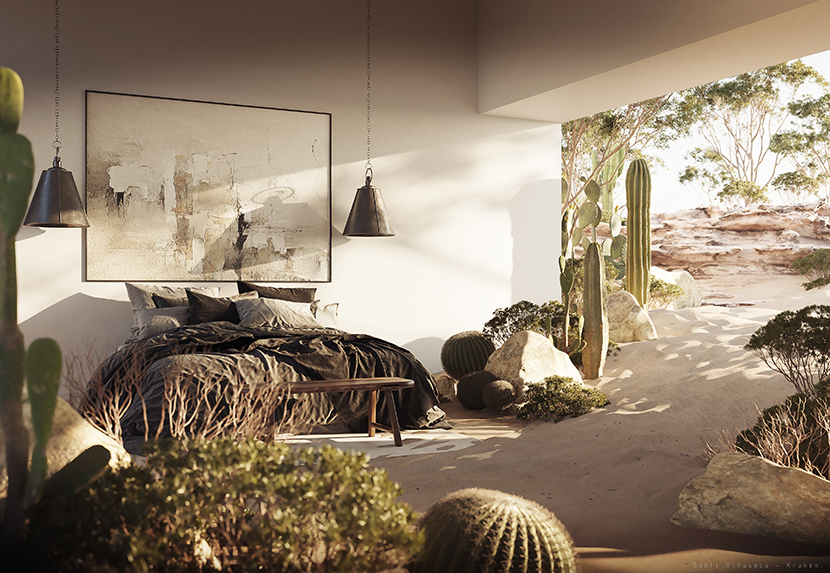 This angle shows the sand flowing into the building.
This angle shows the sand flowing into the building.
In December 2022, you broke 10.000 followers on Instagram, congratulations on reaching this milestone! How important is growing and maintaining an active social media presence in your line of work?
Thank you so much, Sélène and I are thrilled to have reached 10K followers on Instagram! It has been an important milestone for us, especially because it has given us more visibility. We have received so many encouraging messages, requests for advice from young artists, and even new clients. It has been an incredibly positive experience to publish images and see the reactions of our followers, and to have our work shared on other platforms. Our ‘Lake House’ project, for instance, has been reposted hundreds of times around the world, and that kind of chain reaction is very motivating.
Of course, there is a downside to maintaining an active social media presence, and that is the effort it takes. It is a never-ending race to regularly post content, to the extent that it has become part of our daily work routine. Nonetheless, we believe that the benefits outweigh the costs, and we are grateful for the opportunities that social media has given us.
At the beginning of the year, your wife and business partner Sélène launched the interview series InterViz. Can you tell us a bit about this endeavor of hers and the motivation behind it?
Sélène is not only an architect, she also holds a Bachelor's degree in philosophy. Wanting to combine her two passions, she launched InterViz, a monthly interview series that explores current topics such as ecology, artificial intelligence, or leadership. Sélène has always been drawn to the conceptual side of things, exploring the "why" behind images. She could not find this kind of content within the archviz field, so she decided to create it herself. Through these portraits, she shares artists' personal stories, including what drove them to pursue their craft, how they overcame obstacles in expanding their business, and how their relationships or choices in life have shaped their work.
While the artists featured on InterViz are undoubtedly successful, their journeys were not without hurdles. Take András Káldos or Victor Bonafonte, for example, who founded their businesses during a crisis. Their perseverance and ability to adapt to unforeseen circumstances led them down a path they may not have otherwise considered, which is a truly inspiring message for anyone facing their own obstacles. The stories shared on InterViz serve as a reminder that while success may not come easily, it is always worth striving for, especially when you are pursuing something that you are passionate about and continuously seeking to improve.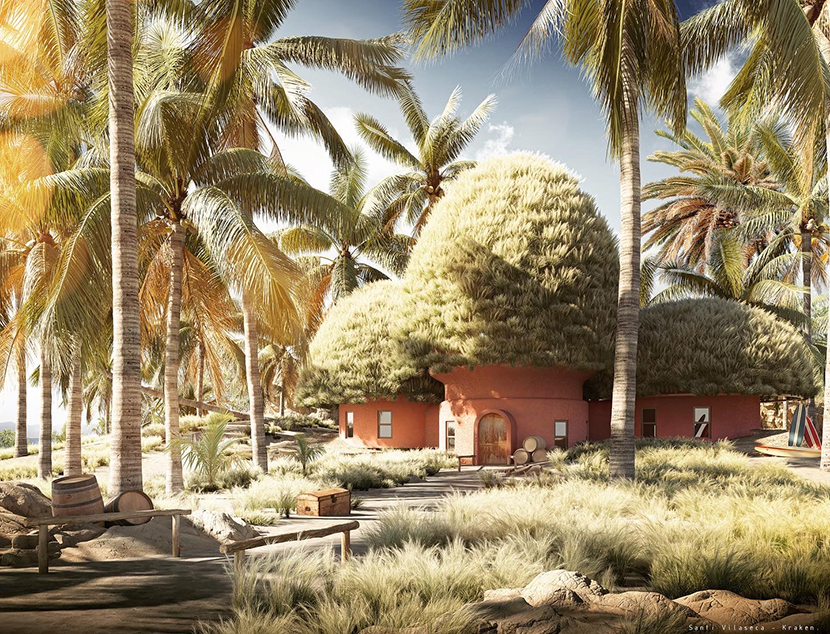 Taking biophilic design to the next level, Santiago’s ‘Mushroom’ series sees beach bungalows roofed with lush vegetation.
Taking biophilic design to the next level, Santiago’s ‘Mushroom’ series sees beach bungalows roofed with lush vegetation.
Now that we are up to speed, we are excited to discuss some of your latest works. Your three most recent submissions to our render farm, ‘Between Worlds’, ‘Jungle Retreat’, and ‘Mushrooms’, all feature symbiotic blends of nature and architecture. Can you first tell us a bit about the origins of each of these three projects?
When Midjourney arrived last July, I was completely taken aback. As someone who loves to draw, I was amazed by the incredible artwork I saw, but my initial excitement turned to disappointment once I realized these images were produced by a "robot". Since I had assumed a human artist had spent hours perfecting every detail of their work, finding out it instead was just a matter of writing a few words and pressing a button, I felt betrayed.
This experience made me seriously question whether we are going too far with technology and how it might affect our understanding of art and creativity. However, I think it ultimately pushed me to further explore the boundaries of fiction. In the past, I enjoyed playing with a very realistic representation of the world, as I liked the idea of people believing my archviz work to be actual architecture. With these new works, I feel like I have surpassed that notion and I am now fully embracing a more fantastical approach, allowing myself more creative freedom and exploring new artistic directions.
While the idea of machines creating art may still be a difficult concept for me to accept, I believe that it is up to us to use technology in a way that benefits and enhances our creative endeavors, rather than replacing them altogether.
Looking through your portfolio, nature is both a permanent and prominent fixture in nearly every project you publish. What is the relation between nature and architecture to you and what makes you keep exploring it?
Nature and architecture have always been deeply intertwined within my artistic vision. I believe that buildings and structures are not just isolated entities, but part of a larger ecosystem that includes the natural world. From the materials we use to build to the way we shape our surroundings, everything has an impact on the environment and vice versa.
I also envision myself within the images that I create, as it is the best way for me to engage others in my designs. If I can picture myself relaxing, recharging my batteries, or peacefully sketching amidst nature in the scenes I create, then others can likely see themselves in these scenarios as well. This is my ultimate goal – to inspire people to connect with and cherish their surroundings.
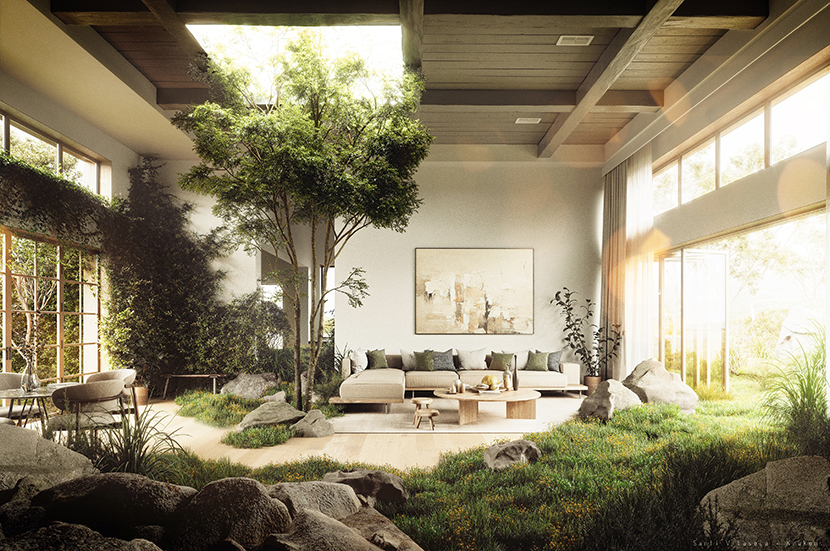 Santiago’s latest work depicts architecture and nature as equal parts of a larger ecosystem.
Santiago’s latest work depicts architecture and nature as equal parts of a larger ecosystem.
Historically and philosophically, this relationship between the natural and the manmade has been commonly characterized as antithetical. You are not only referencing, but directly questioning this duality by carving out a liminal space ‘Between Worlds’. In the eponymous project, you further blur the lines by removing the boundaries between inside and outside.
Can you describe the central ideas behind this project in your own words?
As I have said before, I see nature and the built environment as interconnected rather than opposed, and the ‘Between Worlds’ series is about blurring the boundaries between the two. The inspiration for this series came from an image I once saw of a desert with a door open and sand flowing in, which stuck with me for a long time, and motivated me to literally bring nature into architecture by merging the two worlds completely.
Do you actively ponder these questions when designing a project like ‘Between Worlds’? In how far is your creative process guided by or reflective of rational thought?
I often find that my initial design ideas come from a more intuitive place, and it is only with time and reflection that I realize how my underlying beliefs and values have influenced the outcome. By taking a step back and analyzing my work with a critical eye, I am able to better understand my own creative process and the ways in which I can continue to improve and refine my designs. I think that my philosophy serves as a guiding force in the background, shaping my overall approach to design and helping me make choices that are mindful of the natural world.
Keeping with the theme, the architecture of ‘Between Worlds’ is neither purely functional nor entirely impractical, it is artistic, yet grounded in reality. Can you explain how and why you frequently use archviz as a means of creative expression?
Archviz allows me to showcase the beauty of architecture in whichever way I desire, be it hyperrealistic or purely fictional. By creating 3D visualizations of architectural designs, I am able to bring my ideas to life and share them with others. But I have to say that I also enjoy hand-drawing and the simplicity it offers. There is something very pure and organic about putting pencil to paper, and allowing your ideas to flow freely. While archviz is a powerful tool, sometimes I find that going back to basics and sketching by hand allows me to tap into my creativity in a different way. Plus, there is a certain satisfaction in creating something beautiful using just a few basic tools.
I think that I need a balance between the world of technology and the world without it, and I like to combine these different approaches.
 Escaping the concrete jungle, Santiago seeks digital refuge in his ‘Jungle Retreat’.
Escaping the concrete jungle, Santiago seeks digital refuge in his ‘Jungle Retreat’.
In our last interview you mentioned how you seek creative refuge in your personal projects and your fascination with remote cabins. Now you present us with the overgrown ‘Jungle Retreat’ – another escapist fantasy?
I believe that having a refuge, whatever form it may take, is important for maintaining a healthy work-life balance and staying inspired. Some people might find solace in nature like I do, while others may prefer a cozy spot in their home or a quiet library corner. It is not so much about the specifics of the place, but rather the sense of safety, comfort, and personal connection it provides. Having a refuge can help us recharge, refocus, and face the challenges of daily life with renewed energy.
My kind of refuge is most definitely in a natural setting. It is a place where I could live without the distractions and pressure of modern society. Of course, not everyone shares my passion for rustic, off-the-grid living, but if my images have resonated with anyone, it is likely because some of them at least do identify with this idea. And who knows, maybe one day I will be lucky enough to make my own jungle retreat a reality!
Completing the triad, ‘Mushrooms’ too features some of the themes we just discussed. What more can you tell us about this project and the meaning it holds for you?
For the ‘Mushrooms’ series, I wanted to create images that were full of positive energy and joy. I imagined a happy nation living on a self-sufficient island, free from the stresses and negativity of the outside world. I feel that with so much sad news inundating us on a daily basis, I needed to create something that would provide a refreshing contrast. My philosophy is that the more we expose ourselves to positive things, the more positivity we cultivate within ourselves, and it will make us stronger when facing negativity.
Last time you told us that your more experimental personal projects directly feed into your professional work. What have you learned from the projects we discussed that you can share with us?
I have learned a lot from my recent personal projects, especially in terms of pushing the limits of hyperrealism. While my professional work often aims to realistically showcase our clients' architecture, I have come to realize that, in a world saturated with visual content, what truly stands out are images that have an extra bit of magic, a je-ne-sais-quoi that captures the eye. Clients often have a very specific vision of what they want, but I believe that incorporating this kind of enchantment into our work, we can create more engaging and captivating visuals. So, I am excited to bring these new insights and techniques into my professional work.
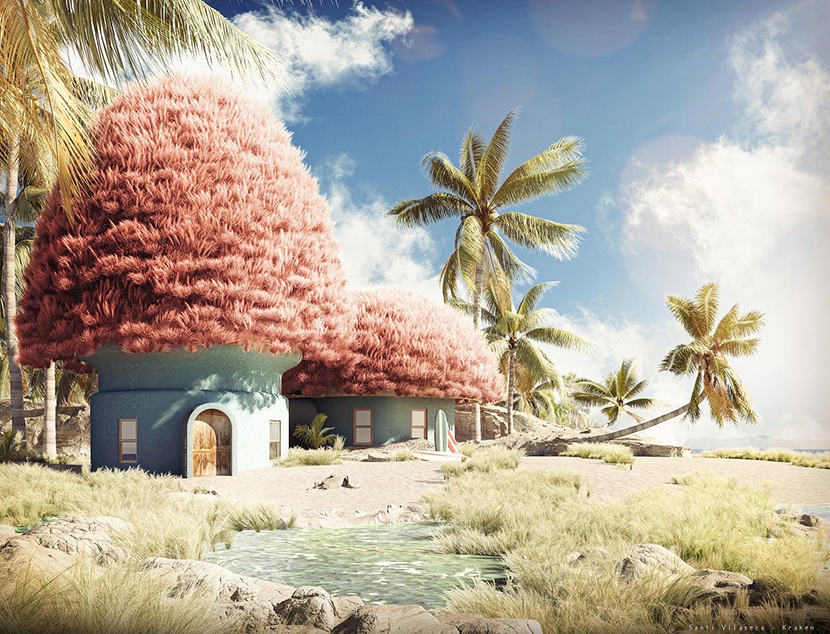 Why take off the rose-tinted glasses? In troubled times we can all use a little positivity and color in our lives!
Why take off the rose-tinted glasses? In troubled times we can all use a little positivity and color in our lives!
Can you tell us about your overall experience with RebusFarm? Is there anything you especially like about our service?
One thing that really stands out to me is your commitment to sustainability with a green energy provider, energy-efficient hardware, and intelligent management software. This is something that my partner Sélène and I are very sensitive to. It is important for us to work with responsible companies that care about the environment.
I also appreciate RebusFarm's role in the archviz community. You hold contests, feature emerging artists, and provide invaluable support to our community. All of which is important to me and makes RebusFarm a key player in the archviz world.
Thank you so much for your kind words! In closing, is there anything else you want to say? Any plugs, shoutouts or present or upcoming projects you would like to mention?
Thank you for choosing me as your Artist of the Month and giving me the opportunity to talk about my work. As someone who lives in the present, I do not really know what my next project will be. There is this Spanish phrase I often repeat when people ask me about my plans for the holidays, the weekend, or the more distant future: "ya se verá" which simply means "we'll see." To me, this phrase represents the idea that we cannot control everything that happens in our lives, but we can control our attitude towards it. We can choose to be optimistic, to focus on the good things, and to be grateful for what we have now. I even had the phrase tattooed on my arm because it serves me as a constant reminder to be mindful of the here and now and to appreciate the beauty of life.
So, once again, I want to thank you for this opportunity, and I encourage everyone to focus on the present, to be grateful for what they have already accomplished, and to choose positivity in their lives. Who knows, maybe if we all think this way, we will make a difference and leave a positive legacy for our children!
Santiago, thank you so much for taking the time and all the best in the future!
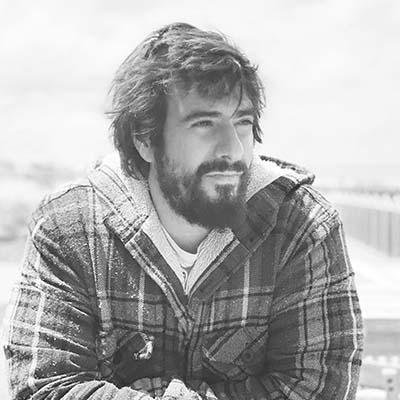
About the artist
Together with his wife Sélène, Santiago Vilaseca manages KRAKEN Studio, a high-end architectural visualization studio based in Paris, France. Combining clear artistic vision and expert technical skill, his images are infused with the magic that captures more than the eyes of the viewer. A strong proponent of biophilic design, his positive attitude is immediately recognizable in his work and words.
